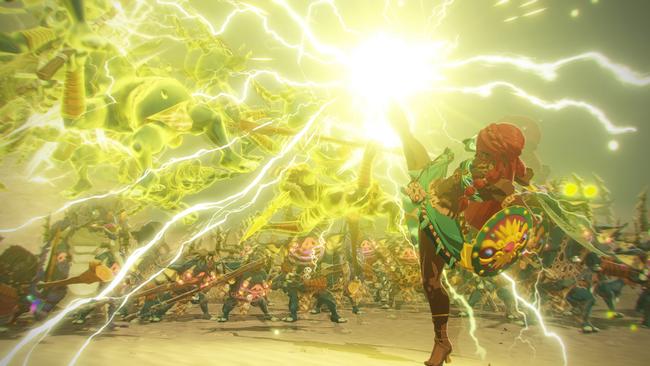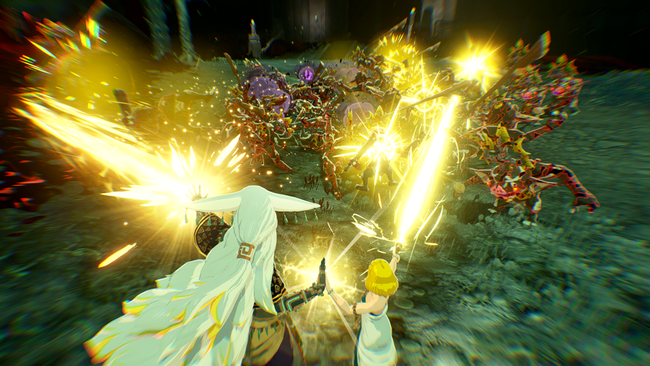
Hyrule Warriors: Age of Imprisonment Review
Sitting down to play Hyrule Warriors: Age of Imprisonment, it comes at no surprise that Tears of the Kingdom's story was at the forefront of my mind - and Age of Calamity's interpretation of Breath of the Wild's backstory to match. While it would be unfair to say that Zelda games haven't really focused on story in the past, I've been of the opinion that the series' recent outings have been a bit of a misstep, albeit ones with quite a lot of promise. I loved the idea of the story going on behind the scenes with Tears of the Kingdom, and existing in a world post-Breath of the Wild, but I was still left wanting in several key areas.
On paper, Age of Imprisonment would be everything I'd wanted out of that original narrative, and could retroactively fill in the blanks for a story that had all the pieces for something moving - but never quite got there for me. Much like with Tears of the Kingdom, however, that would all come down to execution - and it would have to be a fine Warriors game, too.
It's all well and good then that it's a sleeper hit for my personal game of the year.

Let's take a step back for a moment; I have my doubts you'd be reading this review otherwise, but I assume you have at least a passing knowledge of Dynasty Warriors if you have an interest in Age of Imprisonment. The whole 1 vs 1000 power fantasy, mowing down dozens of enemies with a single strike, with only enemy generals and bosses posing any serious challenge. You know if you're a fan of the Warriors gameplay style, as repetitive as it is tackling outposts, decimating enough enemies to spawn a boss, and then taking them down too in order to secure a stronghold.
Much of the changes to the formula that Age of Calamity brought to the table return, though not all. Age of Imprisonment's largest gameplay focus this go around centers around elemental combinations, and more directly coordinating units with Sync Strikes. In addition to the standard Special gauge, all characters now have a Sync gauge, and when multiple units have filled their gauge and are standing next to each other, then they can combine their talents to execute a coordinated strike.
Zelda and Rauru can separately channel beams of light to sweep down enemies, before finishing off with a flourish; the Mysterious Construct can bombard enemies with elemental fruit or bombs as Calamo rides atop his back while it's morphed into the form of a bird. While many characters have their own "default" actions when paired with any character, others have unique reactions when paired with specific characters. Zelda, for example, can have any number of unique Sync Strikes when called upon while the player controls characters like the Mysterious Construct or the other 5 Sages.

Unlike with Special attacks, Sync Strikes ask for active participation from the player - and will actively change gameplay on the fly. Some, like Calamo's default finisher where he'll lay 3 fruit of the player's choosing across the flat of his blade before letting them loose into the crowd of enemies before him, can slightly change their properties depending on player input.
On its own, this is a neat distraction, and help prevent the inherently repetitive stages from becoming overly monotonous. Where things really shine is how some of these Sync Strikes tie into the game's much larger focus on elemental reactions. In stages in Lanayru, some can be shielded by sludge which will help protect them from damage, unless you wash it off with a Zonai Device Hydrant or as part of the Zora Queen Qia's combo finishers. As part of the Rito Chief Raphica's combos, he can set down wind vortexes that can react to other elemental attacks into twisters dealing heavy damage and elemental build-up.
When you Sync with another Sage, you gain their elemental attribute. In that same case with Raphica, this means whenever he's imbued with Fire or Lightning - any attacks that would leave a momentary wind vortex will instantly transform into their respective twisters. The same can be said for Qia's ability to cleanse enemies of sludge when paired with her, of course. When attacking an enemy with a specific elemental weakness, using the right Zonai Device or pairing with the right Sage can make a real difference. This was the case in Age of Calamity, but it truly does feel like a core element of the gameplay loop this time around - especially since you can relatively freely use Zonai Devices as part of your loadout, or even as customizable extensions of certain character's movesets.

These Zonai Devices can also be equipped to your skills, which replaces the Sheikah Slate skills from Age of Calamity. Interjects - the system from Age of Calamity where players could react to enemy actions with a Sheikah Slate skill - are back with a few changes. Character-specific skills are now the primary method of dealing with these telegraphed attacks from major enemies, but specific Zonai Devices and even specific character actions can do the same when your skills are on cooldown. Nearby units that have their skills charged can even be switched to while at the same time interjecting an enemy, with the added benefit that both units Sync gauge will replenish a bit.
The end result of it all is a combat system that feels reactive and engaging, even when the core gameplay loop remains much the same as Warriors games of the past. You're constantly making micro adjustments for what you've got equipped to your units in terms of skills and Zonai Devices, depending on the enemies you're facing. It probably won't quite be enough to convert anyone that isn't already a fan of that gameplay loop, but if you're like me and understand what you're getting into, it's enough to keep you going well past the credit roll. All the characters are simply delights to play; getting into the groove of learning every one of their kits, and decking out their weapons, is a dangerous path to go down.
Character and weapon progression is mostly the same as Age of Calamity, with a few small changes. Unlocking new weapons in and of itself is actually rather rare, and instead it's Zonai Steel that is expended to level up your character's gear. These can have specific Seals with unique buffs attached to them, and the first of these used in a set of enhancements can slot into any slot you unlock in a weapon while increasing their power. At certain level thresholds you'll need to offer a certain number of materials to unlock a weapon's unique attribute. Gaining new abilities and additional Special Gauges for characters works otherwise identical to Age of Calamity.
If you aren't familiar with Age of Calamity, there's a world map where all the game's missions, challenges and objectives take place across Hyrule's various regions. Completing missions to liberate areas of the map in turn unlocks new challenges within the associated regions. Resources gathered within and as rewards from stages can then in turn be used to unlock facilities and upgrades for characters. Icons on the map will denote whether a node is for a specific character's upgrade, and will even denote when a stage will unlock a new playable character for your roster.

I mentioned the game's story near the beginning of the review, and I don't want to go into many specifics about what I found it did right. What I will say, is that I had some concerns that Zelda's own story might end up overshadowed. While Age of Imprisonment is more than just Zelda's story, I felt it struck a good balance between showing Zelda's time spent with Rauru and the Sages, and the new story that the team strived to tell. What I also felt landed well from both a story and gameplay front are the replacement for the Divine Beast segments from Age of Calamity; if you're a fan of Kid Icarus: Uprising or Star Fox 64, you'll probably be in for a treat. They're a great way for setting the stage for the scope of Hyrule at war, and the fidelity on display was greatly appreciated. It all culminates in a conclusion that stands among the Zelda series' very best, and one that I foresee players talking about very fondly in the years to come.
On that note, I played Age of Imprisonment in both handheld and docked mode extensively. I'm pleased to say that while the game isn't a locked 60 FPS, it reaches that framerate target where it counts - with only minor dips when the player is doing something really, really cool on screen, all the while looking great. It's a complete non-issue, even without offering the comparison to Age of Calamity's performance on the original Switch. It just looks and runs well on its own merits. I can't speak to how things hold up using Game Share, but I can't imagine it will be a bad experience with all that considered.
For a certain type of player, Hyrule Warriors: Age of Imprisonment will be the single game you'll end up sinking the most time into on your Switch 2. If it wasn't for every other RPG I've yet to play this year, I might have ended up in those shoes. Age of Imprisonment isn't just a great Zelda spinoff, but confidently stands among some of the singular best games in the entire Zelda series. I simply can't recommend it enough for anyone who is a fan of the Warriors' genre.